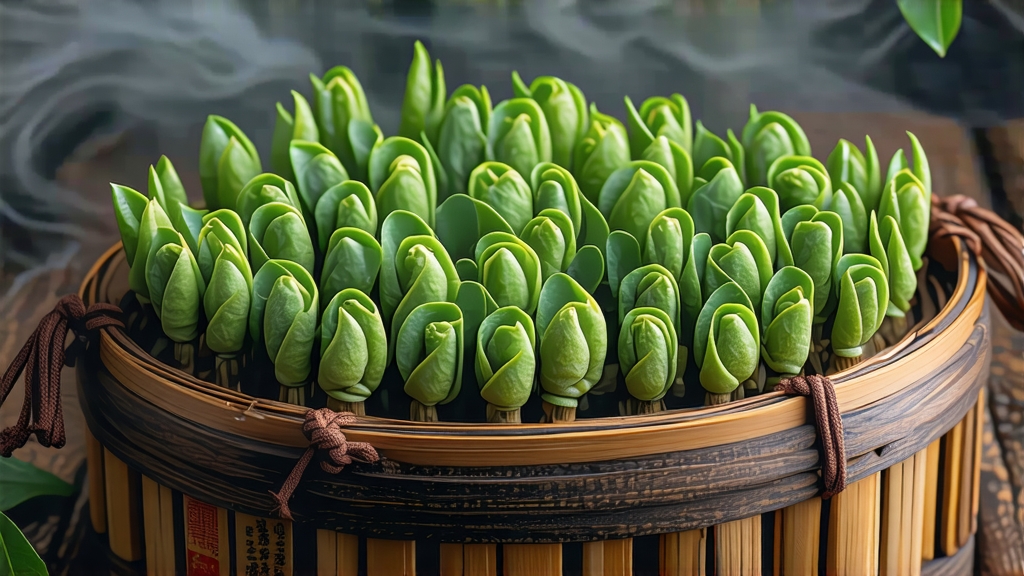
Biluochun, whose name translates literally to “Green Snail Spring,” is one of China’s ten most celebrated teas, yet it remains a quiet treasure beyond the country’s borders. Grown in the mist-locked hinterland of East China’s Dongting Mountain range in Jiangsu Province, this tea is prized for its improbably tiny, spiral-shaped leaves and a fragrance so intense that, according to Qing-dynasty legend, even the local monks once mistook it for the scent of blooming orchids. To understand Biluochun is to step into a world where geography, history, and human craftsmanship converge in a single cup of jade-green liquor.
Historical whispers place Biluochun’s birth during the late Tang dynasty, but its documented fame begins in the Kangxi era (1661-1722). The emperor, touring the Lake Tai region, was offered an unnamed curly tea whose aroma he declared “astonishingly fragrant.” He christened it “Biluochun,” combining “bi” (green), “luo” (snail shell), and “chun” (spring), a nod to both its appearance and its early-spring harvest. Court annals record that the imperial household subsequently reserved the entire first flush for palace tribute, elevating the tea to semi-mythic status.
Although Dongting Mountain is the original and still most revered terroir, Biluochun’s cultivar—traditionally the small-leaf “Fuding” strain—has migrated to nearby counties. Purists divide the tea into three micro-appellations: Dongshan (East Mountain), Xishan (West Mountain), and the outer ring of hilly orchards. Dongshan, a narrow peninsula jutting into Lake Tai, enjoys a microclimate in which cool lake vapors meet warm morning sun, coaxing the bushes into producing especially tender, white-tipped buds. Leaves harvested here fetch prices rivaling top-grade Longjing, yet connoisseurs insist the difference is discernible in the cup: Dongshan Biluochun carries a whisper of water-chestnut sweetness, while Xishan versions lean toward white peach.
The crafting of Biluochun is a race against dawn. Pickers begin at 5 a.m., when mountain mist still clings to the bushes, selecting only the standard “one bud with one unfolding leaf,” rarely longer than 2.5 cm. By 9 a.m. the baskets must reach the village workshop; any delay oxidizes the fragile tips and dulls the signature brightness. The leaves are spread in shallow bamboo trays for two hours of withering, just long enough for surface moisture to evaporate while internal enzymes remain active.
Next comes the most virtuosic step: pan-firing in cast-iron woks heated to 180 °C. A master maker tosses 250 g of leaves with bare hands, relying on muscle memory to judge the exact second when the leaf temperature drops enough to knead without scorching. Using a technique called “cuo tuan”—literally “rub into a ball”—the tea is rolled against the wok in a continuous spiral motion. The heat sets the green color, while the pressure breaks cell walls, releasing aromatic compounds that will later infuse the liquor with orchid and ripe guava notes. After three cycles of firing and rolling, moisture falls below 7 % and the leaves resemble tiny jade snails, their downy tips still visible under a magnifying glass.
Because Biluochun is so early-harvest and so delicate, water choice is critical. Ideal mineral content sits between 30–80 ppm; higher hardness flattens the ethereal fragrance, while distilled water produces a hollow body. Heat water to 75 °C—just below the first bubble string—and use a tall, thin glass or a 150 ml gaiwan. A 1:50 leaf-to-water ratio (3 g to 150 ml) allows the spirals to unfurl vertically, a mesmerizing “tea dance” that doubles as visual entertainment. After a 20-second rinse to awaken the leaves, steep the first infusion for 45 seconds, subsequent steeps adding 15 seconds each. Properly handled, five infusions yield layered aromatics: the first like fresh lychee, the second reminiscent of lily, later steeps revealing a creamy, almost oat-milk finish.
Professional cupping follows a quieter choreography. Warm the tasting set, add 4 g of leaf, and infuse for five minutes with 80 °C water. Evaluate “dry fragrance” by shaking the lid: top-grade Biluochun releases a scent that is simultaneously floral and marine, hint